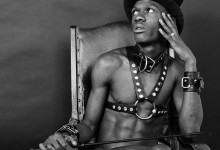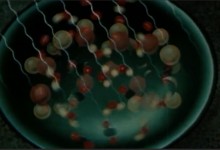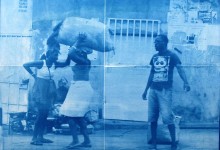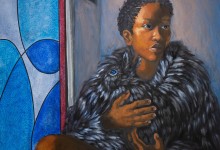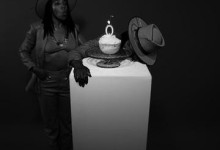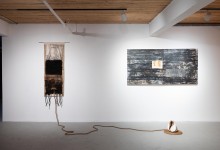Reception: Saturday, November 11, 2023 from 3 p.m. to 5 p.m.
Black transmission: A thousand paths of humanity
Anna Binta Diallo, Marie-Danielle Duval, Gwladys Gambie, Délio Jasse, Mathieu Lacroix, Po B. K. Lomami, Olivier Marboeuf, Ludgi Savon, Stanley Wany, Guy Woueté, Ajamu X
Curator: Olivier Marboeuf
This exhibition is part of the
Af-Flux – Biennale transnationale noire, 2nd edition
Text by Olivier Marboeuf
Translated by Cécilia Bracmort
A scattered community
A black transnational biennial is necessarily a speculative event because it addresses – with all the difficulties that this implied – what a transnational black community might be. In this story, which is constantly being retold, the works are like clues, the distant points of a constellation from which we will attempt to weave, provisionally, this wandering community that we know is both dispersed in space and time. And even that it has been skilfully dispersed by the history of colonial Modernity, its art of lootingand falsely learned lying, of covering up and concealing. This history has been dispersed, rendered illegible, by a series of often violent interruptions, a collection of caesuras, deportations of people and artifacts, annihilations. But it has also dispersed itself to find a good life, to survive and reinvent itself. It is this genius and cunning of the living that circulates beneath necropolitical history that we wish to celebrate by observing how the parcels of a transnational Black history have, can and might communicate in order to reconstruct narratives other than those imposed on us by the dominant order, whether material, political or narrative.
Anti heroism and Black fears : a black archive
We’ll be careful to avoid any black heroism, however, so as to prevent the dazzling trap of a counter-history symmetrical to the one that has already cast so many existences into the shadows. We’ll be taking care of the fragile, incomplete, but secretly visionary gestures of women’s voices in particular, often relegated to the background in authorized historiographies. Only this care can lay the foundations for reparation, for neither people nor objects will be able to find their place again. Everyone is transformed, and we are interested in observing this process of vital transformation and all the interrelations it implies. For we have no desire to erect new statues and celebrate new owners, nor to engage in a black tokenization that would only serve to feed a toxic art market ever hungry for new material to consume. It’s a different history of art and cultural gestures that we wish to be associated with: a living and uncertain history, a history of black multitudes.
What we chose to name the black transmission means multiple/ diverse things. First, this is how we name the way in which weak signals, arts of resistance and ways of doing things manage to circulate from generation to generation. By what path and from what traces, is a Black present constructed that is in no way new but on the contrary possesses a particular thickness? Our curatorial proposal is thus conceived in the context of echoes, of the persistence of traces, based on what exists in some artists and reappears later in others, what was already there in those whom we have perhaps forgotten and whom we choose to honor in a perspective that is not patrimonial but in a gesture of the living. Signs, voices and materials survive and reappear because they haunt minds and bodies. It is the singular nature of this Black archive that will be at the heart of our concerns. Our curatorial project will feature artists of many generations, geographies, social backgrounds, genders and sexualities, both identified artists and others who have sometimes been called outsiders. We know full well that a black transnational constellation always includes stars so bright that no one wants to see them. It’s up to us to connect them through this other way of making history, and of making an archive without owner or heroe.
Transmission and opacity
To the Western diktat of public overexposure as the only desirable form of representation to the empire of transparency, of the raw light of Reason that is supposed to illuminate the obscure worlds of here and elsewhere, Black transmission opposes an aesthetic of opacity and an ecology of shadow. Transmitting through enigma and initiation also means giving full importance to all the powers of the living, human and non-human, visible and invisible, which require special care and attention. This sensitivity to all the voices of the living world is complemented by an art of cunning, an art of slipping under the ear of those who want to know everything and accumulate everything. Faced with the voracity of cultural extractivism, Black transmission is also a skilfull practice of scrambling, of saturation, of a word that serves not to say, to fill space with a noise that only certain ears will be able to decode. We’ll explore this particular circulation of meaning, right down to the ecstatic overexposure of the black body, which can just as easily, by saturating the stage with excess and farce, conceal other strata of underground histories. We’ll be paying particular attention to the uses of visual saturation, to song as coded discourse, but also to sound practices and the singular relationships that Black artists maintain with technologies and their misappropriation.
Transmission and local community: a storytelling mediation
Our interest in transmission is also a way of taking into account the Biennial’s local audience. We want to work in a variety of spaces and forge special links with the city’s community centers in particular. The Afflux Biennial is also an opportunity for us to implement experimental modes of cultural mediation linked to transmission aesthetics associated with orality and storytelling. In our proposal, the figure of the cultural mediator will not be peripheral, but central, as an intermediary / storyteller of the stories that visibly and secretly run through the artistic universes we propose. The construction of a conversational link with the audience, and consideration of their own knowledge, will be one of the keys to our search for a possible form of Black transmission. This will be embodied by the presence of storytelling mediators in the exhibitions but also by public discursive moments when we hope to break free from academic formats to build spaces for shared words and experience, combining film and video viewing, sound listening, storytelling, meals and conversation.



